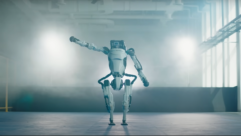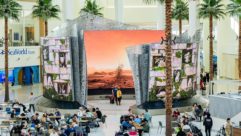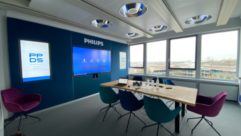
Airport Art
Nov 22, 2013 4:34 PM,
By Tim Kridel and Cynthia Wisehart
New approaches to video display and content delivery seek to transform the traveler experience

The seminal media installation at the recently renovated Tom Bradley International Terminal at Los Angeles International Airport (LAX) demonstrates just how inadequate the phrase “digital signage” can be to describe the dramatic balance of aesthetics, art, and communication.
Take the sheer scale of the video display. Consider a four-sided, 72ft.-tall LED tower, or a 120ft.-wide collage of eight LED screens that seems to float above the retail shops. LCD panels stack six high to create 10 28ft.-tall columns, which Mike Doucette, Los Angeles World Airports chief airport planner, likens to totem poles. Flight information fills a 75ft.-wide LED screen crowned with hundreds of radiating LED sticks. An 84ft. portrait videowall welcomes travelers to the city, and a companion wall bids them bon voyage.
Now imagine high-resolution video content—waterfalls, musical instruments, people, planes, and constellations—soaring playfully across each of these massive surfaces, harmonizing with the high glass walls of the light-flooded terminal, and changing interactively as travelers pass by a video structure or through a video portal.
For example, at the concourse entrances, images and sounds on the LCD “totems” cue realtime factors such as the amount of foot traffic and flight destinations: If a plane is departing for South America, the music might have a Latin theme. Built-in sensors in the columns can respond to passersby and trigger content accordingly. It’s a far cry from the airport signage staples of headline news, advertising, and flight status, and that’s the point. Los Angeles World Airports (LAWA) and the companies it worked with—including MRA International and Sardi Design, and content creator Moment Factory—wanted to create a new role for environmental media. In all, the terminal has seven custom large-scale display structures designed into the architecture. The iconic displays, plus the gate information monitors, comprise an integrated media display platform driven by a single terminal-wide content management system.

“Some people have called this ‘mediature,’” says Bryan Hinckley, account manager at Electrosonic, the project’s systems integrator. “The architecture is coming alive, and it’s about creating a space and the experience for travelers.”
“The thought became, ‘Could it be a little bit more than advertising?,’” LAWA’s Doucette says. “Could it be more entertainment or a feature that’s a passenger experience, whether it’s showcasing the local culture of Los Angeles or the destinations of the world?”
For the Bradley Terminal, design goals influenced the choice of displays in favor of enormous. This gave LED manufacturer Daktronics an unprecedented opportunity to challenge its manufacturing processes and integration techniques, says Project Applications Engineer Adam Gilliland. Many of the very large LED displays required a subtle convex curve, and all required custom architectural integration or framing, such as custom stainless steel framing to blend with the architecture.
For the centerpiece Time Tower—a 72ft.-tall rectangle, so big it requires eight HD signals for coverage—Gilliland says they got a chance to test the accuracy of the company’s manufacturing. “The LED wraps the tower and the corners are very sharp 90-degree angles,” he notes. “It’s a single integrated LED, so over that kind of distance and with variations in the structure, any small error would have really added up to alignment problems. There was a lot riding on the tolerances of our LED.”
Daktronics also worked with the content and control team to ensure the images would synchronize seamlessly on the four sides of the tower. For everyone, the overarching goal was pixel-for-pixel consistency throughout the process from media creation through playback, processing, and display—there was no video scaling to fall back on. A similar challenge presented for the Story Board LED collage—“a huge palette of pixels,” says Electrosonic’s Hinckley, that required a consistent image across eight separate but integrated LED screens. To maintain the integrity of the images and audio, accommodate new content, and ensure that the system continues to function smoothly alongside the airport’s critical safety and operational systems, Electrosonic maintains an onsite staff.
Airport Art
Nov 22, 2013 4:34 PM,
By Tim Kridel and Cynthia Wisehart
New approaches to video display and content delivery seek to transform the traveler experience

These portals at the north and south entrances are made from stacked LCD screens with embedded sensors that can cue content based on realtime information such as foot traffic. They can show independent images or combine for a single image.
In addition to working with the architects and technical partners onsite, Daktronics further supported the custom content process with a series of mockups at a facility in Long Beach, Calif., and in the content creators’ production facilities in Montreal (Moment Factory) and Los Angeles (Digital Kitchen). This allowed artists to test image resolution, composition and mapping, and to experiment with the different display surfaces such as LED under diffused glass.
Daktronics also supported the maintenance staff with an invisible access door in the face of the 84in.-tall LED welcome wall, designed and reinforced to maintain that invisibility over time and use.
It is a combined 9,500 square feet of video canvas. As such, it requires a new approach to envisioning and delivering content. Designer Mike Rubin of MRA International calls it an Integrated Environmental Media System (IEMS). Developed by MRA with the Los Angeles World Airport’s (LAWA) executive team, IEMS describes a network of highly visual displays—each with a distinct identity and purpose—served by a flexible content management system that can be customized for various functions including media sponsorships. The content system provides an integrated scheduler and automated controller, nicknamed “Isaac,” that enables mapping content onto the unique, very large-scale, multi-dimensional media surfaces with no loss of sync, registration, or resolution, says Stephan Villet, co-founder of Smart Monkeys, which designed and programmed the system.
The backbone for this merger between AV and IT is an enterprise-class Cisco switch, says Smart Monkey partner Alan Anderson. “It needs to be rock solid for the scale of data it manages for the media features and to control hundreds of devices from the LED displays to the video players.”
Smart Monkeys modeled the system on a design the company created last year for Universal Studios Orlando’s new Lagoon show and parade. “We have over 40 Windows and Linux Virtual Machines (VMs) in a cluster, so all media or show control is virtualized and operates in a fault-tolerant mode on three Dell enterprise servers simultaneously,” Anderson explains. The servers have associated SANs adequate for their needs.
In this virtualization architecture—where the storage, operator GUI, VPN, routing, and other functions are distributed across multiple servers—if one fails, the others instantly pick up the slack. This maximizes uptime, which is why Google and other major IT companies use virtualization architecture for a variety of mission-critical applications.
“The AV industry has been really slow in embracing virtualization,” Villet says. “But in airports, they have very few people talking AV; they have large departments focused on IT. We had a lot of people from the IT department coming to the meetings. When we explained everything about virtualization, they felt very comfortable with it, even though hasn’t been anything like this in any other airport.”

Electrosonic designed the layout and installed the Main Equipment Room (MER), which is comprised of a control and rack room. Miles of optical fiber from all over the terminal feed into the MER, where more than 1,000 individual connections provide the capability to display and control the content displayed on each feature. Cameras in the terminal that show the content-display status of each feature allows a single operator to monitor all features simultaneously. Additionally, a 65in. display was installed in the control room where new media content from prospective partners will be reviewed prior to public display.
Two “complementary paradigms” are at work in delivering the video, Anderson says. “First, we had to map high-quality HD content to LED walls with frame sync and video genlock. So we needed multiple servers for a single media feature.” Seven Grass Valley 4-channel K2 Summit broadcast servers, configured in a bank of 28 video channels, meet this need for HD playback to the terminal’s video channels.
Additionally, the video needs to be interactive, whether based on human interaction like sensors and touch, or the interaction with databases, Internet, and data feeds from the outside. PC-based generative X-Agora video servers from Moment Factory fill the interactivity needs.
Airport Art
Nov 22, 2013 4:34 PM,
By Tim Kridel and Cynthia Wisehart
New approaches to video display and content delivery seek to transform the traveler experience

The 75ft.-wide Destination Board is crowned with aluminum-encased LED sticks.
Operators ingest video files and prepare them for scheduling with a web-based GUI to create a capsule or collection of video files that need to play in sync on a particular media feature. Once files are previewed and validated, the operator schedules the content into the system.
The schedule is database-driven and feeds three Medialon Manager Pro systems; one handles the logical portion of the control system with video ingest and control room monitoring and the second controls all the equipment for the main LED features’ playback and physical playout. The third controls all the gate information displays as well as systems’ clock and sync.
“We looked at what IT does, what broadcast does, what AV needs, and we used that information to create one control system with the best of networking, virtualization, and broadcast operations,” Villet sums up.

The centerpiece Time Tower has Daktronics LED walls on four sides. On one side there is also a functioning clock and a partial screen of diffused glass over the LED.
Environmental media systems aren’t cheap and neither is the content, so an obvious question is, how can airports justify the additional expense versus conventional, ad-focused networks? The business case can be summed up as a belief that a superior traveling experience will attract more travelers, who will choose connecting airports based on amenities.
LAX commissioned a study into the annual economic impact of a 747 or A380 plane full of international travelers passing through multiple times a week during the course of a year.
“Each one of those generates $600 million in the local economy,” LAWA’s Doucette says. “You don’t want to be losing flights to other cities because of the quality of your facilities. It’s not good for business. It’s not good for the City of Los Angeles.”
The IEMS platform could attract additional advertisers, premium rates, or both, all of which would help the return on investment. At the very least, the media display features requires new types of content because simply blowing up existing ads and other programming won’t fly, nor would traditional advertising models.
“We don’t like to call it digital signage because the intent is to move away from advertisements and to get into sponsorships,” Villet says.
For example, a set of signage might show loops of striking digital art that ends with the sponsor’s name and logo. LAX is looking for companies that can deliver that new breed of content.
“Instead of an advertising contract, we’re thinking about it in terms of a ‘terminal media operator,’ as we’re calling them now,” Doucette says. “We’ve developed about 4 hours of original programming because we didn’t have a media operator in place. We’re looking for them to help us develop additional content.”
Doucette thinks that incumbents such as Clear Channel or JCDecaux will have a role to some extent. “But we’re also looking for them to bring someone who understands these media systems and how to leverage that into the quality of the advertising and/or sponsorships that we expect to see in this environment.”
IEMS DISPLAY COMPONENTS
LAX’s recently renovated Tom Bradley International Terminal includes seven major AV features, collectively dubbed the Integrated Environmental Media System (IEMS). Nearly two years in the making, and comprising 9,500 square feet of combined active display, the $50 million IEMS includes:
- The Time Tower: This structure is 72ft. tall and 20ft. to 25ft. wide, depending on the face with a based of diffused glass panels and an elevator shaft running through the center. It includes a mix of 6mm to 7mm and 10mm to 11mm Daktronics LED tiles that display dramatic mapped images and react with particles effects to the gestures of passengers as they approach the tower.
- The Story Board: This 120ft.-long feature consists of 6mm to 7mm Daktronics LED tiles combined to create five display walls of varying size and configuration.
- The Destination Board: 75ft. long by 15ft. high, this 6mm to 7mm Daktronics LED display is partitioned into a central flight information display and two side panel displays with additional informational content.
- The Welcome Wall: Featuring 6mm to 7mm Daktroincs LED tiles and divided into two screens, the wall is about 84ft. tall by 26ft. wide. An invisible service door is incorporated into the display face. The Bon Voyage Wall has the same resolution but is 23ft. high by 13ft. wide.
- North and South Portals: These consist of 10 28ft. columns of stacked 55in. Planar Matrix LCD monitors. Infrared scanners and speakers inside react to passengers walking by and fluidly affect the content’s images and sound.










